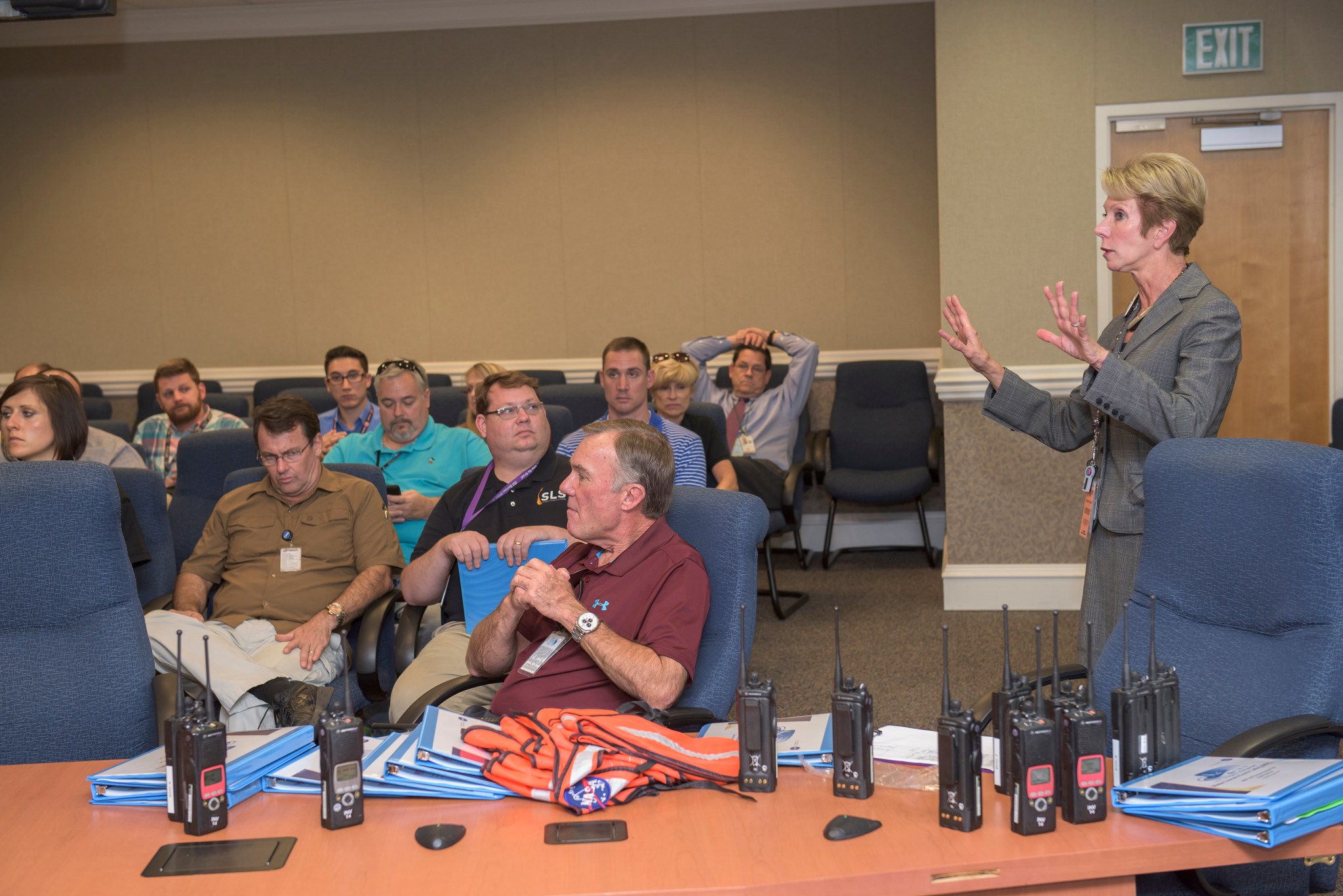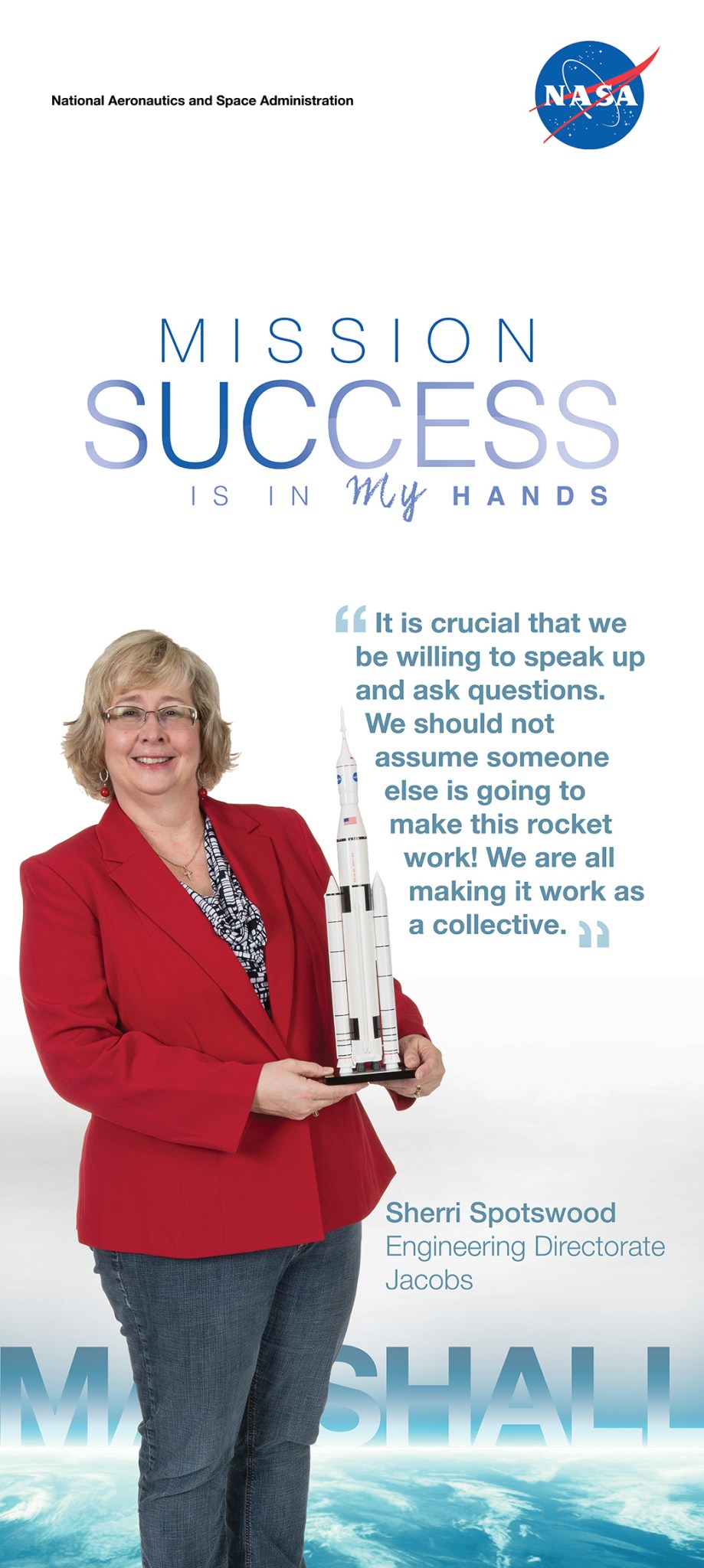In This Week’s Star
- NASA Completes Critical Design Review for Space Launch System
- More Than 50 Pieces of Hardware Completed for SLS Core Stage Tanks
- Towers of Steel for New SLS Test Stand Rising at Marshall
- Caregiving Can Change a Life: Marshall to Host Combined Federal Campaign Mini Charity Fair on Oct. 29
- National College Students Complete Robotics Workshop at Marshall Center
- Active Shooter Exercise Prepares Marshall Center for Emergency Situations
- Mission Success Is in My Hands: Q&A with Marshall Engineer Sherri Spotswood
- Marshall to Host Native American Heritage Event and Food Sampling Nov. 3
- Marshall Team Members Support Athletes at 2015 Special Olympics
- This Week in NASA History: First Saturn Launch Vehicle, SA-1, Launches — Oct. 27, 1961
- Completed Critical Design Review of SLS Featured On ‘This Week @NASA’
NASA Completes Critical Design Review for Space Launch System
By Megan Davidson
For the first time in almost 40 years, a NASA human-rated rocket has completed all steps needed to clear a critical design review. The agency’s Space Launch System is the first vehicle designed to meet the challenges of the journey to Mars and the first exploration class rocket since the Saturn V.
SLS will be the most powerful rocket ever built and, with the agency’s Orion spacecraft, will launch America into a new era of exploration to destinations beyond Earth’s orbit. The CDR provided a final look at the design and development of the integrated launch vehicle before full-scale fabrication begins.
“We’ve nailed down the design of SLS, we’ve successfully completed the first round of testing of the rocket’s engines and boosters, and all the major components for the first flight are now in production,” said Bill Hill, deputy associate administrator of NASA’s Exploration Systems Development Division. “There have been challenges, and there will be more ahead, but this review gives us confidence that we are on the right track for the first flight of SLS and using it to extend permanent human presence into deep space.”
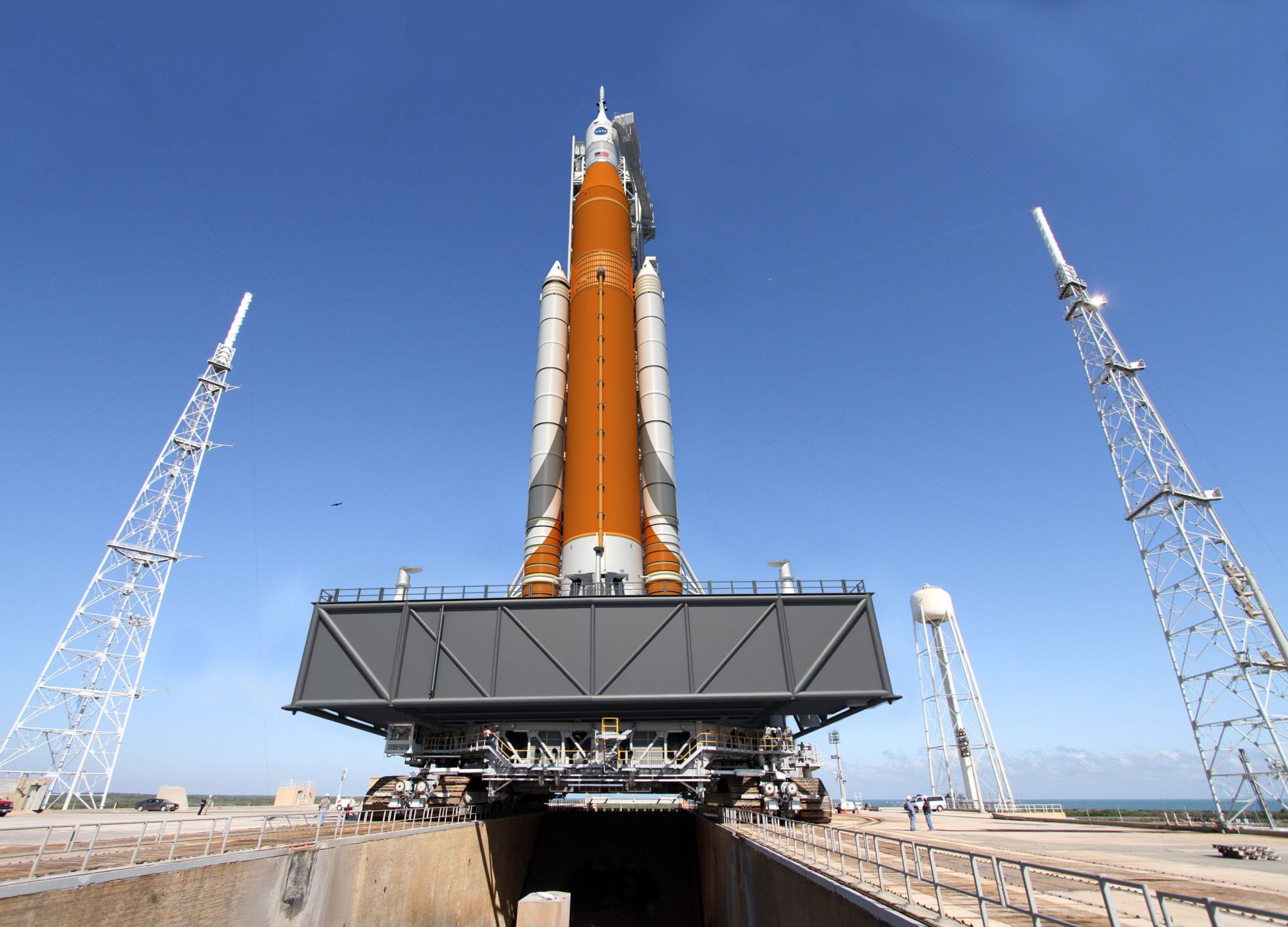
The CDR examined the first of three configurations planned for the rocket, referred to as SLS Block 1. The Block 1 configuration will have a minimum 70-metric-ton (77-ton) lift capability and be powered by twin boosters and four RS-25 engines. The next planned upgrade of SLS, Block 1B, would use a more powerful exploration upper stage for more ambitious missions with a 105-metric-ton (115-ton) lift capacity. Block 2 will add a pair of advanced solid or liquid propellant boosters to provide a 130-metric-ton (143-ton) lift capacity. In each configuration, SLS will continue to use the same core stage and four RS-25 engines.
The SLS Program completed the review in July, in conjunction with a separate review by the Standing Review Board, which is composed of seasoned experts from NASA and industry who are independent of the program. Throughout the course of 11 weeks, 13 teams — made up of senior engineers and aerospace experts across the agency and industry — reviewed more than 1,000 SLS documents and more than 150 GB of data as part of the comprehensive assessment process at NASA’s Marshall Space Flight Center, where SLS is managed for the agency.
The Standing Review Board reviewed and assessed the program’s readiness and confirmed the technical effort is on track to complete system development and meet performance requirements on budget and on schedule.
The program briefed the results of the review in October to the Agency Program Management Council, led by NASA Associate Administrator Robert Lightfoot, as the final step in the CDR process.
This review is the last of four reviews that examine concepts and designs. The next step for the program is design certification, which will take place in 2017 after manufacturing, integration and testing is complete. The design certification will compare the actual final product to the rocket’s design. The final review, the flight readiness review, will take place just prior to the 2018 flight readiness date.
“This is a major step in the design and readiness of SLS,” said John Honeycutt, SLS program manager. “Our team has worked extremely hard, and we are moving forward with building this rocket. We are qualifying hardware, building structural test articles, and making real progress.”
Story continued here. Watch a video on CDR here.
Davidson, an ASRC Federal/Analytical Services employee, supports the Office of Strategic Analysis & Communications.
More Than 50 Pieces of Hardware Completed for SLS Core Stage Tanks
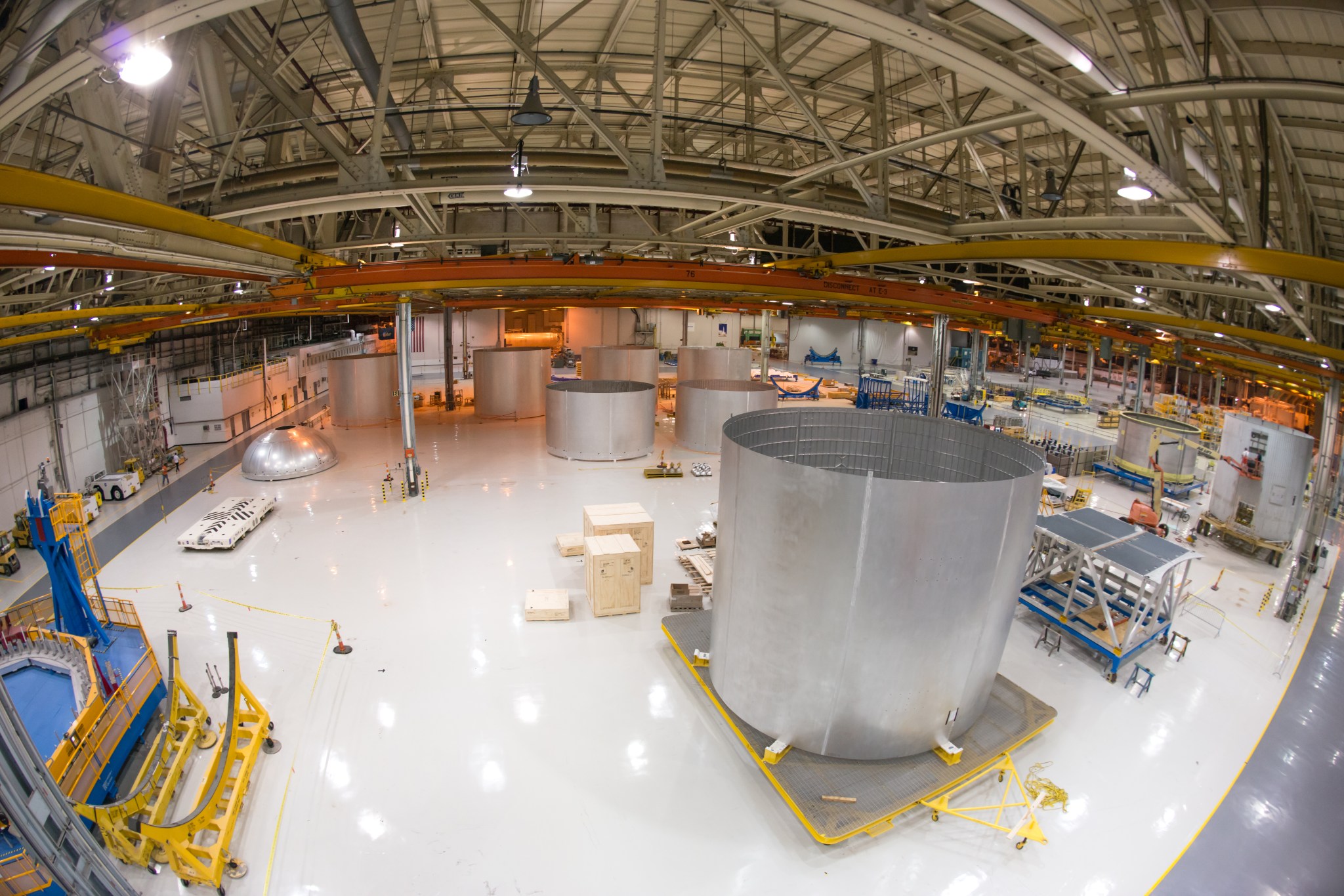
Technicians at NASA’s Michoud Assembly Facility have completed more than 50 pieces of flight and qualification hardware for the liquid oxygen and liquid hydrogen tanks for the agency’s new rocket, the Space Launch System, and are ready to move forward with welding. SLS will be the most powerful launch vehicle ever built for deep space missions, including to an asteroid placed in lunar orbit and ultimately to Mars. The core stage, towering more than 200 feet, will store cryogenic liquid hydrogen and liquid oxygen that will feed the vehicle’s four RS-25 engines. The qualification hardware will be used to make test versions of the tanks. When completed, the test version tanks will be shipped aboard the Pegasus barge to NASA’s Marshall Space Flight Center for structural loads testing on new stands currently being built. The flight hardware will be used on the maiden flight of SLS, called Exploration Mission-1. Watch a video on the progress at Michoud.
Towers of Steel for New SLS Test Stand Rising at Marshall
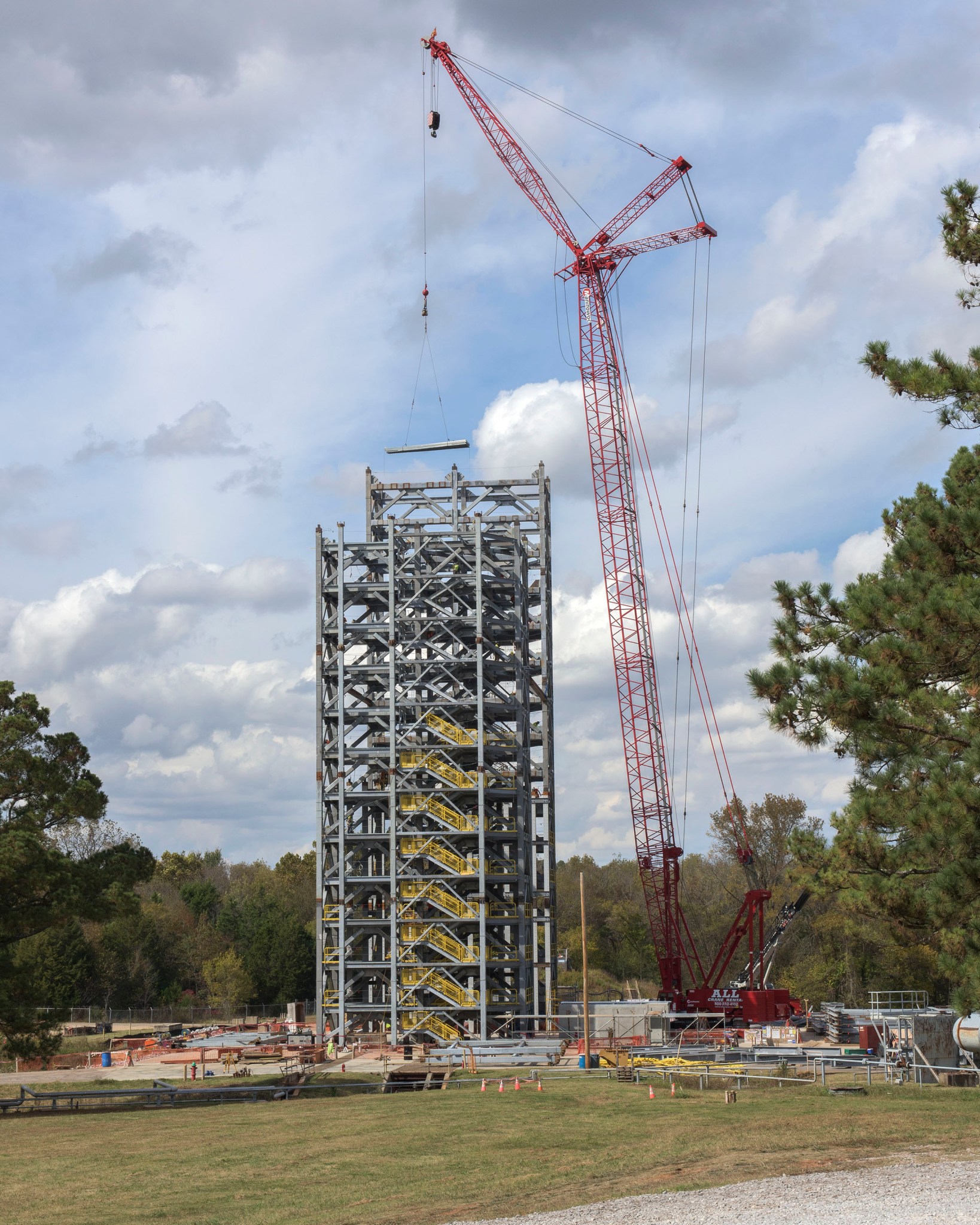
Steel is rising for two towers that will compose a 215-foot-tall structural test stand for NASA’s Space Launch System at the Marshall Space Flight Center. The first tiers were welded into place on Aug. 31, and the towers now are already visible above the tree line. When construction is completed, hydraulic cylinders at Test Stand 4693 will push, pull and bend the liquid hydrogen tank of the SLS’s massive core stage to subject the tank and hardware to the same loads and stresses they will endure during launch. SLS, the most powerful rocket ever built, will carry astronauts in NASA’s Orion spacecraft on deep space missions, including to an asteroid placed in lunar orbit and on the journey to Mars. The new test stand is designed to accommodate future tests of different tank sizes and other equipment, in addition to the SLS core stage liquid hydrogen tank. It is being built in Marshall’s West Test Area on the foundation of the stand where the Apollo Saturn V F-1 engine was tested during the 1960s.
Caregiving Can Change a Life: Marshall to Host Combined Federal Campaign Mini Charity Fair on Oct. 29
On Oct. 29 NASA’s Marshall Space Flight Center will host a Combined Federal Campaign mini charity fair from 10:30 a.m. to 1:30 p.m. in Building 4203. All Marshall team members are invited to stop by and talk with representatives from 10 local nonprofit organizations related to care giving and learn about their work and beneficiaries.
Participating charities include CASA of Madison County; New Hope Children’s Clinic; Agape of North Alabama; Hospice of the Valley; Child, Youth, and School Services; AL Non-Violent Offenders Organization; United Way of Madison County; North Alabama Center for Educational Excellence; Loving Arms Adult Day Services, Inc.; and the Alliance for Opportunity and Development.
Laptop computers will be available during the event for team members to make on-the-spot pledges using a NASA PIV Smartcard and PIN or an Employee Express user name and password.
This mini charity fair is the first in a series of three to be hosted by the 2015 CFC Committee. Each event will have a theme focusing on the type of service provided by the specific charities that are represented. Upcoming charity fairs are scheduled for Nov. 10 and Dec. 3.
For more information about CFC mini fairs, please contact Rhoney Triplett.
National College Students Complete Robotics Workshop at Marshall Center
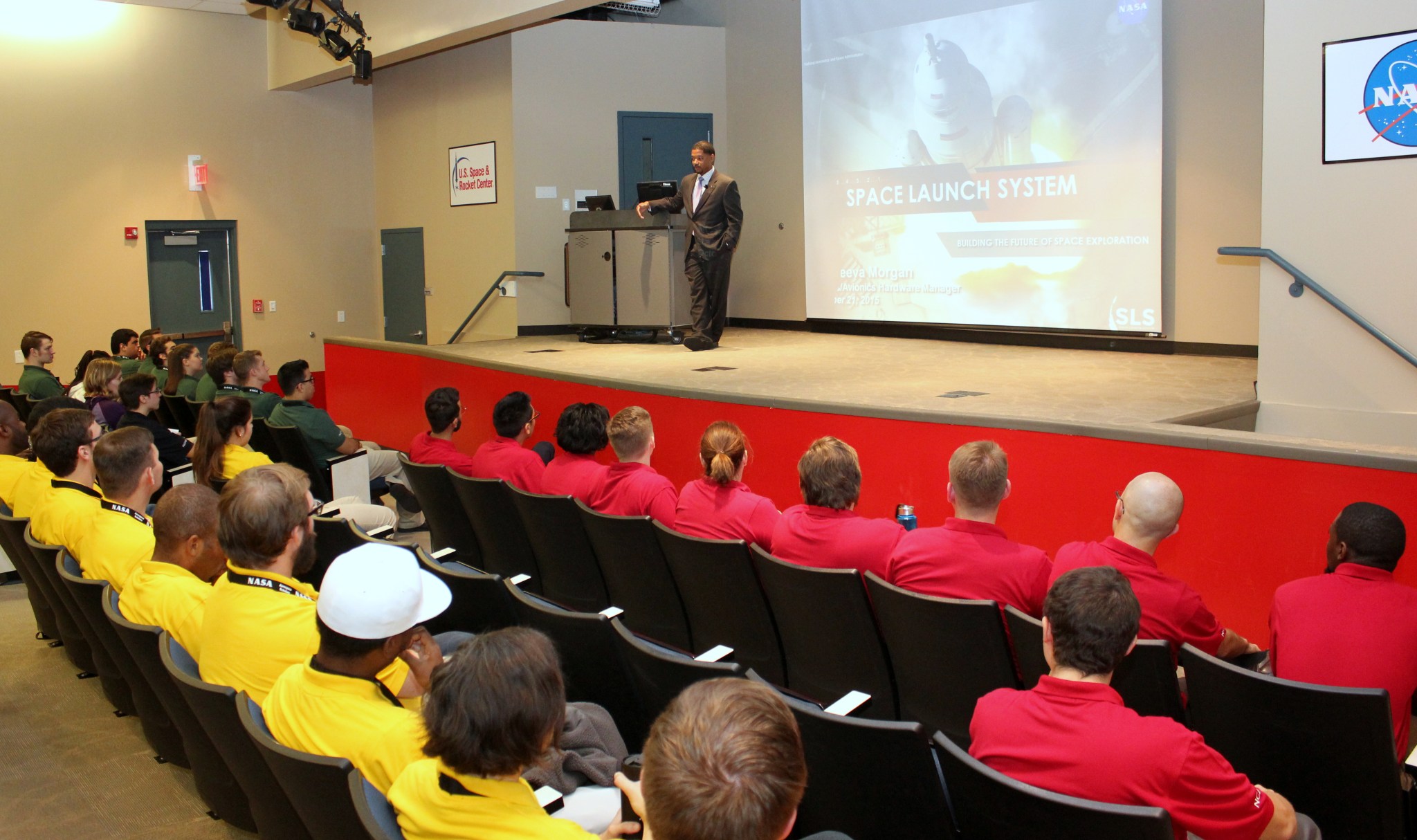
Markeeva Morgan, avionics hardware manager for NASA’s Space Launch System, details the progress and manufacturing milestones of NASA’s new deep-space exploration rocket to 35 students attending a NASA Community College Aerospace Scholars workshop at NASA’s Marshall Space Flight Center Oct 20-23. The event encourages students from minority-serving community and junior colleges across the nation to pursue careers in the STEM fields of science, technology, engineering and mathematics. Through a competitive process, U.S. citizens currently pursuing their initial undergraduate degree at a community college are eligible to apply for the series of online activities and on-site experiences. During this four-day workshop, students developed and implemented a simulated robotic mission to improve their understanding of the real-world skills used by the NASA workforce, including project management, computer science and engineering.
Active Shooter Exercise Prepares Marshall Center for Emergency Situations
By Jena Rowe
Active shooter emergencies are all too familiar incidents chronicled in recent news headlines across our nation. NASA’s Marshall Space Flight Center is taking measures to properly train and equip Marshall team members if such an incident occurred at our workplace. On Oct. 22, the Marshall Emergency Management Office conducted a full-scale active shooter exercise that tested Marshall’s emergency response and preparedness actions.
“Emergency exercises such as these help to prepare and train the workforce and first responders for the unthinkable whether at work or at home,” said Carole Valenti, emergency management director at Marshall. “Training in a controlled environment equips people with necessary skills and provides them with an opportunity to determine what might be the best possible reaction if they are ever faced with an uncontrolled emergency.”
During the exercise scenario, a mock shooter entered the cafeteria in Building 4203 with a concealed weapon. Once in the cafeteria during the mock enactment, the gunman openly fired blank rounds at designated exercise volunteers. “Even though we knew it was not a real situation, we still felt anticipation and adrenaline when the shooter entered the cafeteria and shots were fired,” said Barbara Jo Webb and Evan Dial, Marshall ExplorNet community managers who participated in the roles of cafeteria patrons during the exercise.
Plain-clothes officers from Marshall’s Office of the Inspector General were also in the cafeteria and were able to neutralize the shooter just before Marshall Uniformed Police arrived to secure the incident scene. Redstone Arsenal Fire Department and the Huntsville Emergency Medical Services, Inc. (HEMSI) also participated in the training exercise. HEMSI provided the critical role triaging the staged victims and evacuating more seriously injured individuals, just as they are trained to do in trauma centers and emergency situations.
After the exercise was completed and Marshall team members were notified that the situation had been contained, exercise participants met to discuss lessons learned, challenges faced, and if the training was helpful. “During and after the exercise, I found myself mentally evaluating what I would and wouldn’t do if this had been a real active shooter,” said Dial.
“We believe the exercise went well — and the effort and time put into this training by each volunteer, the emergency response team and safety personnel did not go unnoticed,” said Valenti. “Because of their participation, we are making confident steps toward teaching people throughout the center to know what messages to listen for and how to respond in emergency situations.”
Marshall’s Emergency Operations Center has resources that can help you know what to do in an emergency situation such as an active shooter. Available electronically and in print, the Emergency Procedure Handbook is an easy-to-use, employee desk guide with emergency information and contact numbers. The Emergency Procedures App for iOS and Android devices is available for download, as well as a Web application that is available for desktop computers. Marshall team members are also encouraged to sign up for NIXLE text messages to receive emergency messages in real time.
In the coming weeks, the EOC will analyze actions that were taken during the active shooter exercise and plan for another exercise in 2016. For more information about what to do in an emergency situation, visit the Emergency Management site on ExplorNet or by call 256-544-3131.
Rowe, an ASRC Federal/Analytical Services employee, supports the Office of Strategic Analysis & Communications.
Mission Success Is in My Hands: Q&A with Marshall Engineer Sherri Spotswood
Sherri Spotswood, engineer with Jacobs Technology, Inc./ESSSA Group, supporting the Engineering Directorate at NASA’s Marshall Space Flight Center, recently talked with Marshall Public Affairs Officer Molly Porter about “Mission Success Is in Our Hands,” an initiative underway at Marshall to strengthen team members’ commitment to mission assurance and flight safety.
Years at Marshall:
23 years, 15 with NASA and 8 with Jacobs ESSSA Group.
What are the key responsibilities of your current job?
I’m responsible for vehicle propulsion systems engineering and integration across the Space Launch System Program and Ground Systems Development and Operations.
How does your work support the safety and success of NASA and Marshall missions?
I support the propulsion discipline lead engineer for SLS in the Propulsion Systems Department. We ensure that potential impacts to SLS propulsion systems are assessed by the right technical experts. Conversely, we also make sure that changes to SLS propulsion systems are shared with the right people and assessed for impacts to the vehicle, elements or other programs.
What does “Mission Success Is in Our Hands” mean to you?
To me, it means that we are all critical to making our missions safe and successful. Ours is a complex, multi-faceted and multi-disciplined endeavor. It is crucial that we’re willing to speak up and ask questions. It’s essential that we understand that we may have perspective, experience or knowledge that makes the difference in solving large and small problems.
Do you have a story or personal experience you can share that might help others understand the significance of mission assurance or flight safety? What did you learn from it?
This is my first assignment at the vehicle level, having always worked on engines or the main propulsion system. I am continually amazed at the breadth and depth of technical skills that are required to make SLS happen — not just for the rocket science, but for keeping the team on the same page and moving forward. Every contribution, down to the smallest detail, is important to the mission.
How can we work together better to achieve mission success?
Have conversations in person. Don’t be afraid to ask questions. Think about the big picture, not just your part of the puzzle. Most of all, be engaged and listen. It’s crucial that we be willing to speak up and ask questions. We should not assume someone else is going to make this rocket work! We are all making it work as a collective.
Is there another question you wished we would’ve asked?
Yes. Is it worth it?…You bet!
Do you have anything else you’d like to share?
Yes. It is easy to get lost in the daily grind and forget that one day, when SLS flies for the first time, we will be in awe of what we have accomplished together. We must keep that vision in our minds.
Marshall to Host Native American Heritage Event and Food Sampling Nov. 3
By Brian C. Massey
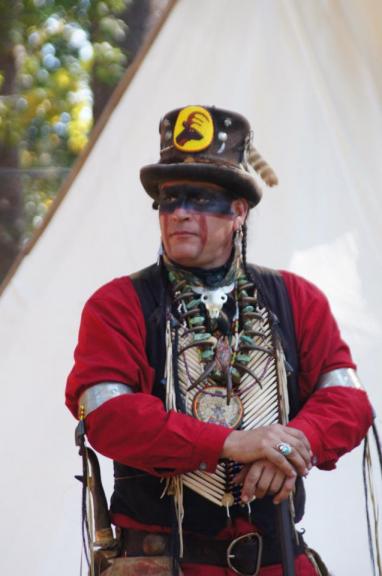
NASA’s Marshall Space Flight Center will host a special Native American Heritage event and food sampling Nov. 3 to honor the contributions, achievements, sacrifices and cultural and historical legacy of American Indians.
The special emphasis program — sponsored by the Office of Diversity and Equal Opportunity — is part of national Native American Heritage Month, and will be held on the lawn of the Activities Building, Building 4316, at 11:30 a.m.
November, designated as Native American Heritage Month in 1990, is a time to celebrate rich and diverse cultures, traditions and histories and to acknowledge the important contributions of Native Americans. It is also a time to learn about tribes and to raise awareness about the challenges facing American Indians.
The event will be highlighted by a performance from dancer, singer and Native culture educator, Little Big Mountain of the Kahnawake Mohawk Territory in Canada. A fourth-generation dancer, Little has been performing and educating across North America for over 40 years. The Big Mountain family began performing in the 1800s and has continued through the generations.
A Native American food sampling, featuring Indian Fry Bread and Three Sisters Soup, will follow the performance.
For more information about the program, contact Cindy Spidel at 256-544-0144 or cindy.spidel@nasa.gov.
For more information about National Native American Heritage Month, click here.
Massey, an ASRC Federal/Analytical Services employee and the Marshall Star editor, supports the Office of Strategic Analysis & Communications.
Marshall Team Members Support Athletes at 2015 Special Olympics
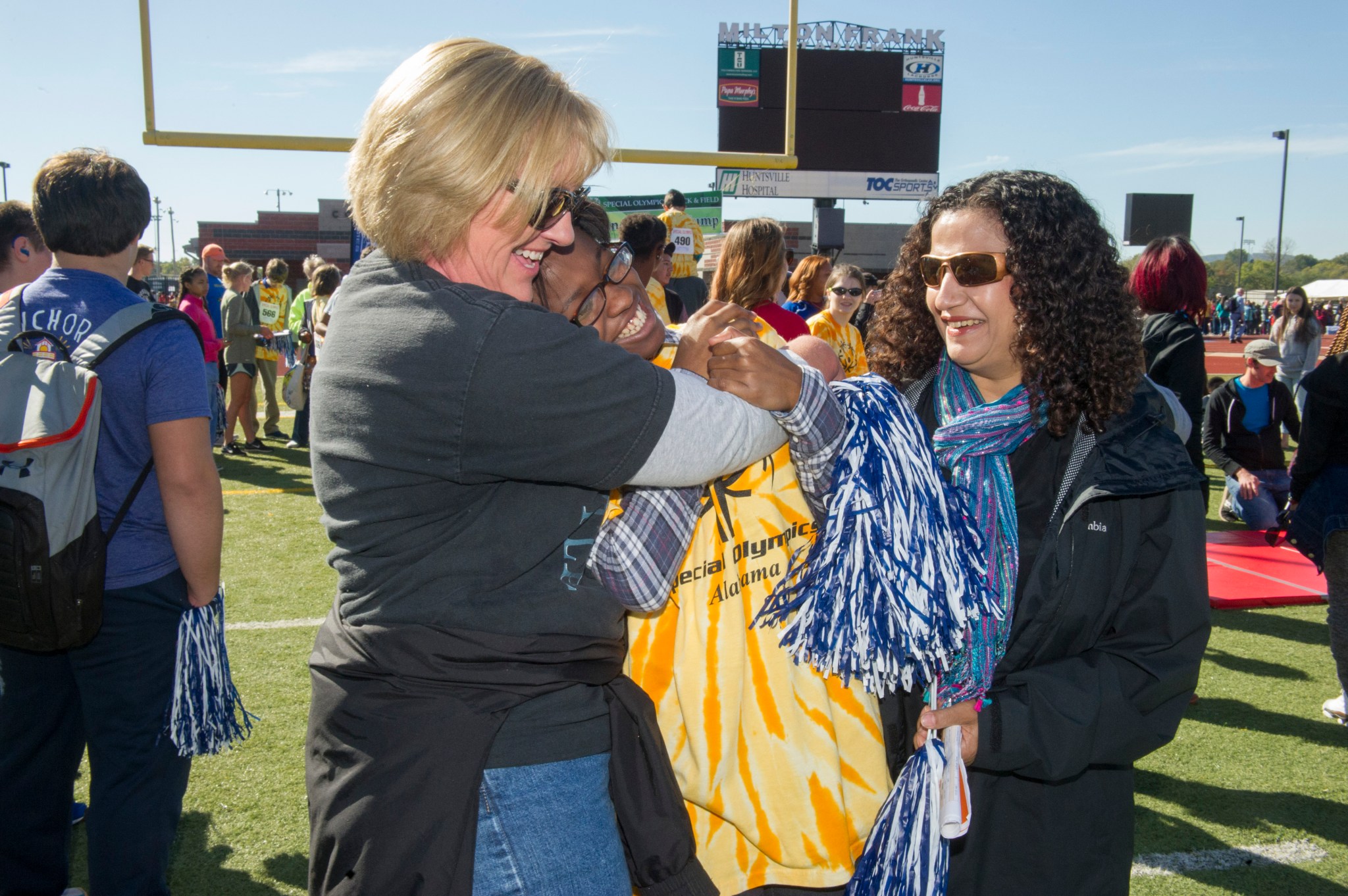
Betty Amos, left, and Adesh Singhal, right, both of the International Space Station Office at NASA’s Marshall Space Flight Center, congratulate Shamya Anderson, center, a sophomore at New Hope High School, on her successful standing long jump at the 2015 Special Olympics on Oct. 20 at Milton Frank Stadium in Huntsville. Amos and Singhal were two of the 101 Marshall team members who volunteered at the Special Olympics as a part of the Marshall Combined Federal Campaign service days. For more information on CFC volunteer opportunities, visit the CFC site on ExplorNet.
This Week in NASA History: First Saturn Launch Vehicle, SA-1, Launches — Oct. 27, 1961
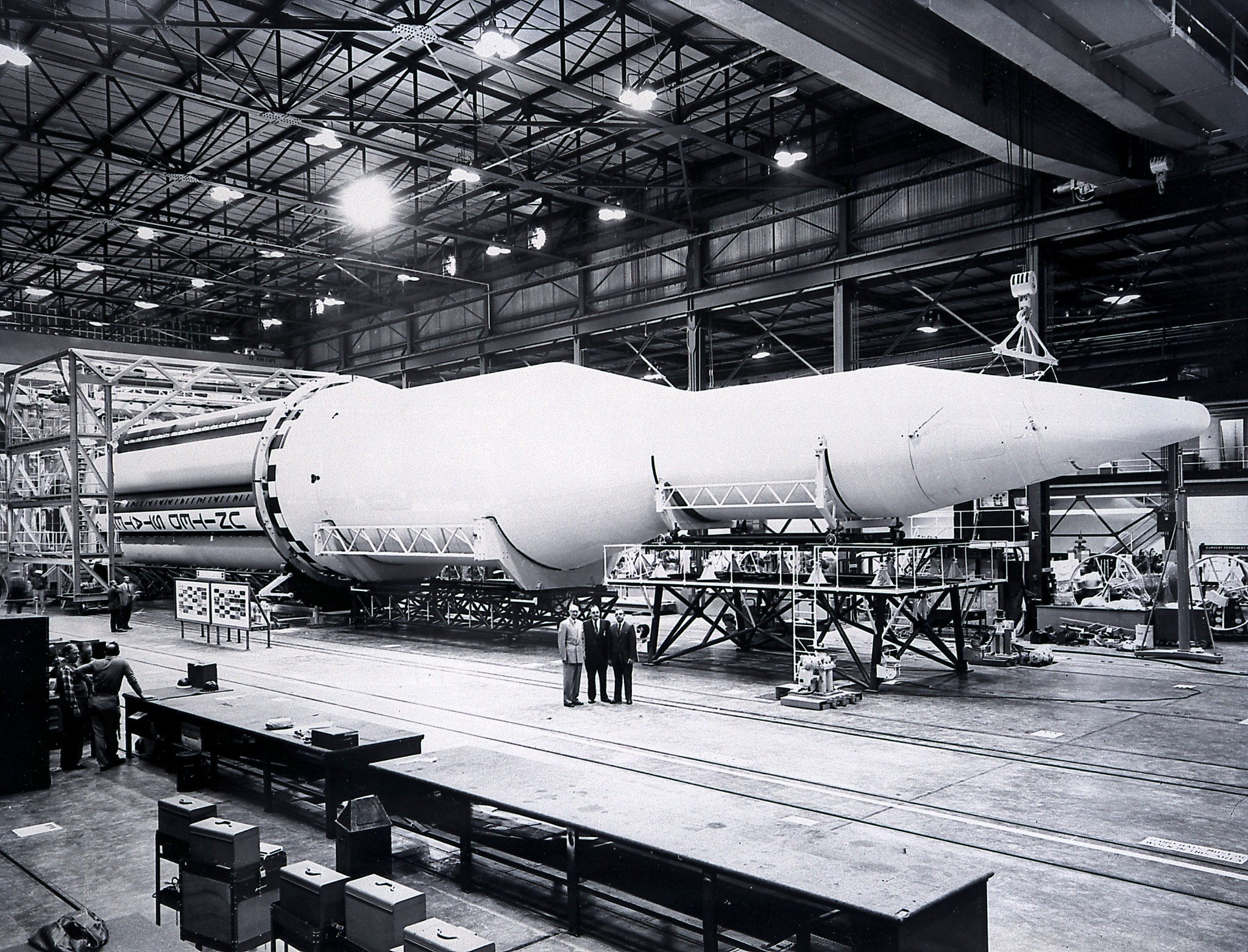
This week in 1961, the first Saturn launch vehicle, SA-1, launched from NASA’s Kennedy Space Center. The Saturn I launch vehicle was built at NASA Marshall Space Flight Center’s Fabrication and Assembly Engineering Division. The NASA History Program documents and preserves NASA’s remarkable history through a variety of products — photos, press kits, press releases, mission transcripts and administrators’ speeches. For more pictures like this one and to connect to NASA’s history, visit the History Program’s Web page.
Completed Critical Design Review of SLS Featured On ‘This Week @NASA’
The successful completion of the Critical Design Review for NASA’s Space Launch System rocket is featured in the latest edition of “This Week @NASA,” a weekly video program broadcast nationwide on NASA-TV and posted online.
For the first time in almost 40 years, a NASA human-rated rocket completed all of the steps necessary to clear its critical design review. NASA’s new, deep-space exploration rocket is the first vehicle designed to meet the challenges of the journey to Mars and the first exploration class rocket built since the Apollo Saturn V. The SLS will be the most powerful rocket ever built and, with the agency’s Orion spacecraft, will launch America into a new era of human space exploration to destinations beyond Earth’s orbit, including to an asteroid and Mars
View this and previous episodes at “This Week @NASA” or at https://www.youtube.com/user/NASAtelevision.



























